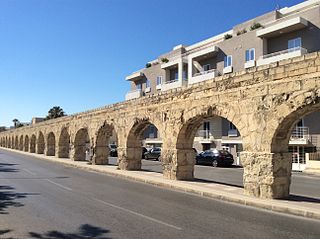
Ross Fountain is a cast-iron structure located in West Princes Street Gardens, Edinburgh. It was installed in 1872 and restored in 2018.

Ross Fountain is a cast-iron structure located in West Princes Street Gardens, Edinburgh. It was installed in 1872 and restored in 2018.

The Ross Fountain was produced at the iron foundry of Antoine Durenne in Sommevoire, France. [1] It was an exhibit at the Great Exhibition of 1862. [2]
It was purchased by gunmaker Daniel Ross in 1862 for £2,000 and subsequently gifted to the city of Edinburgh. It was transported to Leith in 1869 in 122 pieces. [3] It was installed in its current position in 1872. It had some extensive restoration work completed in 2001. [3]

Water was turned off in 2008 and it was closed again from July 2017 for further restoration work undertaken by Lost Art Limited of Wigan on behalf of The Ross Development Trust, costing 1.9 million pounds. [4]
On 8 July 2018, it was re-inaugurated by Lord Provost Frank Ross and others, including the Head of Mission at the French Consulate in Edinburgh Emmanuel Cocher. [5] [6]
The fountain is now painted in turquoise, brown and gold. According to the organisers, the paintwork should last for at least 20 years. The fountain has a new pump and will be switched on permanently.

SS Great Britain is a museum ship and former passenger steamship that was advanced for her time. She was the largest passenger ship in the world from 1845 to 1853. She was designed by Isambard Kingdom Brunel (1806–1859), for the Great Western Steamship Company's transatlantic service between Bristol and New York City. While other ships had been built of iron or equipped with a screw propeller, Great Britain was the first to combine these features in a large ocean-going ship. She was the first iron steamer to cross the Atlantic Ocean, which she did in 1845, in 14 days.

Sefton Park is a public park in south Liverpool, England. The park is in a district of the same name, located roughly within the historic bounds of the large area of Toxteth Park. Neighbouring districts include modern-day Toxteth, Aigburth, Mossley Hill, Wavertree and St Michael's Hamlet.

The Trevi Fountain is an 18th-century fountain in the Trevi district in Rome, Italy, designed by Italian architect Nicola Salvi and completed by Giuseppe Pannini in 1762 and several others. Standing 26.3 metres (86 ft) high and 49.15 metres (161.3 ft) wide, it is the largest Baroque fountain in the city and one of the most famous fountains in the world.

HMS Warrior is a 40-gun steam-powered armoured frigate built for the Royal Navy in 1859–1861. She was the name ship of the Warrior-class ironclads. Warrior and her sister ship HMS Black Prince were the first armour-plated, iron-hulled warships, and were built in response to France's launching in 1859 of the first ocean-going ironclad warship, the wooden-hulled Gloire. Warrior conducted a publicity tour of Great Britain in 1863 and spent her active career with the Channel Squadron. Obsolescent following the 1873 commissioning of the mastless and more capable HMS Devastation, she was placed in reserve in 1875, and was "paid off" – decommissioned – in 1883.

A urinal is a sanitary plumbing fixture for urination only. Urinals are often provided in public toilets for male users in Western countries. They are usually used in a standing position. Urinals can be with manual flushing, automatic flushing, or without flushing, as is the case for waterless urinals. They can be arranged as single sanitary fixtures or in a trough design without privacy walls. Urinals designed for females also exist but are rare. It is possible for females to use stand-up urinals using a female urination device.

Glasgow Green is a park in the east end of Glasgow, Scotland, on the north bank of the River Clyde. Established in the 15th century, it is the oldest park in the city. It connects to the south via the St Andrew's Suspension Bridge.

Princes Street Gardens are two adjacent public parks in the centre of Edinburgh, Scotland, lying in the shadow of Edinburgh Castle. The Gardens were created in the 1820s following the long draining of the Nor Loch and building of the New Town, beginning in the 1760s.

SS Nomadic is a former tender of the White Star Line, launched on 25 April 1911 at Belfast, that is now on display in Belfast's Titanic Quarter. She was built to transfer passengers and mail to and from the ocean liners RMS Olympic and RMS Titanic. She is the only surviving vessel designed by Thomas Andrews, who also helped design those two ocean liners, and the last White Star Line vessel in existence today.

Bethesda Terrace and Fountain are two architectural features overlooking the southern shore of the Lake in New York City's Central Park. The fountain, with its Angel of the Waters statue, is located in the center of the terrace.

Fountain of Time, or simply Time, is a sculpture by Lorado Taft, measuring 126 feet 10 inches (38.66 m) in length, situated at the western edge of the Midway Plaisance within Washington Park in Chicago, Illinois, in the United States. The sculpture is inspired by Henry Austin Dobson's poem "Paradox of Time". Its 100 figures passing before Father Time were created as a monument to the 100 years of peace between the United States and the United Kingdom following the Treaty of Ghent in 1814. Father Time faces the 100 from across a water basin. The fountain's water was turned on in 1920, and the sculpture was dedicated in 1922. It is a contributing structure to the Washington Park United States Registered Historic District, which is a National Register of Historic Places listing.
David MacGibbon and Thomas Ross were Scottish architects. Their practice, MacGibbon and Ross was established in 1872 and continued until 1914. They are best known today for their comprehensive published surveys of Scotland's architectural heritage.

Olantigh is an English house 1 mile (1.6 km) north of Wye in the civil parish of Wye with Hinxhill.

Pearson Park, originally known as the People's Park is a park in the west of Kingston upon Hull, England. It is situated about 1 mile (1.5 km) north-west of the city centre of Hull with its main entrance on Beverley Road and its western boundary adjoining Princes Avenue.

The Saracen Foundry was the better-known name for the Possilpark, Glasgow-based foundry company W MacFarlane & Co. Ltd, founded and owned by Walter MacFarlane. MacFarlane's was the most important manufacturer of ornamental ironwork in Scotland.

Thelnetham Windmill, also known as Button's Mill is a Grade II* listed tower mill constructed of brick. The windmill is located at Thelnetham, Suffolk, England. It was built in the early nineteenth century to grind wheat into flour. Thelnetham windmill worked by wind power until 1924, latterly on two sails, after which it became derelict.

The Boy with the Leaking Boot is a statue showing a young boy, with a bare right foot, holding up his right boot and looking at it. The statue is about 4 feet (1.2 m) tall, and in many cases forms a fountain, with water emerging from the toe of the boot. There are at least 24, and reportedly "hundreds" of examples. The origins of the statue are obscure. The boy is reported to be a young Italian newspaper seller who drowned, or an American army drummer-boy who carried water in his leaking boot to help fallen comrades, or a young fire-fighter either using his boot in a bucket chain or emptying his boot after an incident, or possibly none of these. The statue has also been called The Boy with the Leaky Boot, Boy Immigrant and Unfortunate Boot.

The Bartholdi Fountain is a monumental public fountain, designed by Frédéric Auguste Bartholdi, who later created the Statue of Liberty. The fountain was originally made for the 1876 Centennial Exposition in Philadelphia, Pennsylvania, and is now located at the corner of Independence Avenue and First Street, SW, in the United States Botanic Garden, on the grounds of the United States Capitol, in Washington D.C.

The Wignacourt Aqueduct is a 17th-century aqueduct in Malta, which was built by the Order of Saint John to carry water from springs in Dingli and Rabat to the newly built capital city Valletta. The aqueduct carried water through underground pipes and over arched viaducts across depressions in the ground.

Pulitzer Fountain is an outdoor fountain located in Manhattan's Grand Army Plaza in New York. The fountain is named after newspaper publisher Joseph Pulitzer who died in 1911 having bequeathed $50,000 for the creation of the fountain. Pulitzer intended his fountain to be "like those in the Place de la Concorde, Paris, France." The fountain was designed by the architect Thomas Hastings, and crowned by a statue conceived by the sculptor Karl Bitter. The fountain was dedicated in May 1916.

A nasone, also called a fontanella, is a type of drinking fountain found in Rome, Italy. Literally meaning "large nose", they got their name from their characteristic design first introduced in the 1870s. There are approximately 2,500–2,800 nasoni in Rome, supplying people with free drinking water.